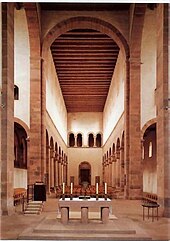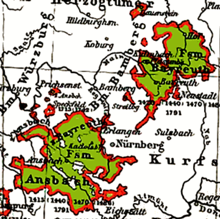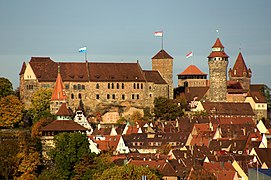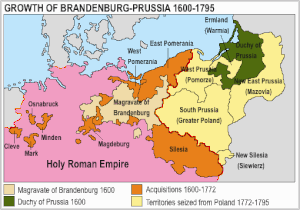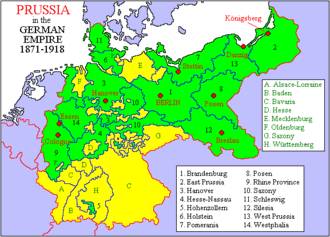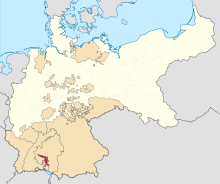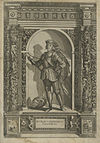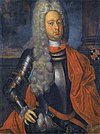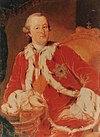Hohenzollern House
La house of Hohenzollern (in German): Haus Hohenzollern, pronounced###############(![]() listen)in Romanian: House of Hohenzollern) was a prominent German royal dynasty (and from 1871 to 1918, imperial) whose members were princes, electors, kings and emperors of Hohenzollern, Brandenburg, Prussia, the German Empire and Romania.
listen)in Romanian: House of Hohenzollern) was a prominent German royal dynasty (and from 1871 to 1918, imperial) whose members were princes, electors, kings and emperors of Hohenzollern, Brandenburg, Prussia, the German Empire and Romania.
It originates from a family of Swabian counts of the 11th century or XII, heirs to the Margraves and Teutonic Knights, and the earliest ancestors of the Hohenzollerns are mentioned in a monk's chronicle in the year 1061. Their name derives from Zollern, a castle from the 13th century — Hohenzollern castle — that the family owned in the surroundings of the city of Hechingen in Swabia – today near Stuttgart, about 30 kilometers south of Tübingen, in Baden-Wurttemberg. Although its origin dates back to the 12th century, the Hohenzollern dynasty is not one of the oldest sovereign dynasties in the German sphere..
The Hohenzollern family split into two branches, the Catholic Swabian branch and the Protestant Franconian branch, which ruled the Nuremberg Burgraviate and later became the Brandenburg-Prussian branch. The Swabian branch ruled the principalities of Hohenzollern-Hechingen and Hohenzollern-Sigmaringen until 1849, and also ruled Romania from 1866 to 1947. Members of the Franconian branch became Margraves of Brandenburg in 1415 and Dukes of Prussia in 1525.
The dynasty was part of the Electors of the Holy Roman Empire beginning in the 15th century. The Margraviate of Brandenburg and the Duchy of Prussia were ruled in personal union after 1618 and were called Brandenburg-Prussia. After reaching its consolidation, embodied in the power of Prussia, in 1701 the Kingdom of Prussia was created, building a set of palaces in Berlin and its surroundings. With Frederick II the Great, Prussia began to increase its power within the German States, which was consolidated by the figure of William I of Germany, who was the architect of the creation of the German Empire in 1871 after the victory in the Franco-Prussian War., with the Hohenzollerns as hereditary German Emperors and Kings of Prussia.
Germany's defeat in World War I in 1918 led to the German Revolution. With the abdication of Wilhelm II, the Weimar Republic was established, thus ending the German monarchy and the Prussian monarchy. The last monarch of the dynasty to hold a throne in Europe was Michael I of Romania, of the House of Romania.
Since 1994, the head of the dynasty —and therefore of the ownership of the royal house of Prussia and the Imperial House of Germany— has been Jorge Federico, although Germany being a federal republic, he does not hold any de facto monarchical position. Karl Frederick of Hohenzollern has been the head of the old Swabian princely line since 2010.
Zollern County
Zollern, from 1218 Hohenzollern, was a county of the Holy Roman Empire. Later its capital was Hechingen.
The Hohenzollerns named their estates after the Hohenzollern castle in the Swabian Alps. Hohenzollern Castle is located on a 855 meter high mountain called Hohenzollern. It still belongs to the family today.
The dynasty was first mentioned in 1061. According to the medieval chronicler Berthold of Reichenau, Burcard I, Count of Zollern (of Zolorin) was born before 1025 and died in 1061.
In 1095, Count Adalbert of Zollern founded the Benedictine monastery of Alpirsbach, located in the Black Forest.
The Zollerns received the title Graf from Emperor Henry V in 1111.
As loyal vassals of the Swabian Hohenstaufen dynasty, they were able to significantly expand their territory. Count Frederick III (c. 1139 - c. 1200) accompanied Emperor Frederick Barbarossa against Henry the Lion in 1180 and, through his marriage, was granted the Nuremberg Burgraviate by Emperor Henry VI in 1192. Around 1185, he became he had married Sophia of Raabs, the daughter of Conrad II, burgrave of Nuremberg. After the death of Conrad II, who left no male heirs, Frederick III was granted Nuremberg as burgrave Frederick I. In 1218, the burgraviate passed to Frederick's eldest son, Conrad I, thus becoming the ancestor of the Franconian branch of the Hohenzollerns, which acquired the Electorate of Brandenburg in 1415.Template:Clear left
Counts of Zollern (1061-1204)
- up to 1061: Burcardo I
- before 1125: Federico I
- Come in. 1125 and 1142: Federico II, eldest son of Federico I
- Come in. 1143 and 1150-1155: Burcardo II, second oldest son of Federico I
- Come in. 1150–1155 and 1160: Gotfried de Zimmern, fourth oldest son of Federico I
- before 1171 - c. 1200: Federico III/I (son of Federico II, also burgrave of Nuremberg)
After Federico's death, his sons divided the family lands among themselves:
- Conrado I received the county of Zollern and exchanged it for the Burgraviate of Nuremberg with his younger brother Federico IV in 1218, thus founding the branch of Franconia of the House of Hohenzollern. The members of the Franconia line finally became the branch of Brandenburg-Prussia and then became Protestantism.
- Federico IV received the burgraviate of Nuremberg in 1200 of his father and exchanged it in the county of Zollern in 1218 with his brother, thus founding the suaba branch of the House of Hohenzollern, which remained Catholic.
Francon branch
The main Franconian branch of the House of Hohenzollern was founded by Conrad I, Burgrave of Nuremberg (1186-1261).
The family supported the Hohenstaufen and Habsburg rulers of the Holy Roman Empire during the 12th to XV, being rewarded with several territorial concessions. Beginning in the 16th century, this branch of the family became Protestant and decided to expand through marriage and purchase policies from the surrounding lands. In the first phase, the family gradually added to their lands, at first with many small acquisitions in the Franconian region of Germany:
- Ansbach in 1331
- Kulmbach in 1340
In the second phase, the family further expanded its holdings with major acquisitions in the Brandenburg and Prussian regions of present-day Germany and Poland:
- Margraviate of Brandenburg in 1417
- Duchy of Prussia in 1525
These acquisitions eventually brought the Franconian Hohenzollerns from a minor German princely family to one of the most important dynasties in Europe.
From January 8, 1701, the title of Elector of Brandenburg was joined to the title of king "in" Prussia and, from September 13, 1772, to King of Prussia.
Burgraves of Nuremberg (1192-1427)
- 1192-1200/1204: Federico I (1139-1200/1204), originally Federico III, count of Zollern, married to Sofia, daughter of Conrado II, then became a burgrave through this union;
- 1204-1218: Federico II (1188-1255, the youngest son of Federico I, also count of Zollern as Federico IV);
- 1218-1261/1262: Conrado I el Piadoso (ca. 1186-1261/2, eldest son of Federico I, brother of Federico II), also count of Zollern as Conrado III;
- 1262-1297: Federico III the Heir (ca. 1218-1297, son of Conrado I);
- 1297-1300: John I (ca. 1279-1300, the eldest son of Frederick III), ruled with his brother Frederick IV;
- 1297/1300-1332: Federico IV (1287-1332, the youngest son of Frederick III and the brother of John I), took the government of the brograviate to the death of his brother;
- 1332-1357: John II the Purchaser (1309-1357, son of Frederick IV);
- 1357-1397: Federico V (1333-1397, son of John II);
On the death of Frederick V on January 21, 1398, his lands were divided between his two sons:
- 1397-1420: John III/I (1369-1420, son of Frederick V), also Margrave of Brandenburg-Kulmbach since 1398;
- 1398-1427: Federico VI (1371-1440, son of Federico V), like Federico I, also margrave of Brandenburg-Ansbach since 1398, Elector of Brandenburg since 1415, Margrave of Brandenburg since 1417 and Margrave of Brandenburg-Kulmbach since 1420.
After the death of John III/I on June 11, 1420, the margraviates of Brandenburg-Ansbach and Brandenburg-Kulmbach were briefly reunited under Frederick VI/I/I. He ruled the Margraviate of Brandenburg-Ansbach after 1398. From 1420, he became Margrave of Brandenburg-Kulmbach. Starting in 1411, Frederick VI became Governor of Brandenburg and later Elector and Margrave of Brandenburg as Frederick I. On his death on September 21, 1440, his territories were divided among his sons:
- John II, Margrave of Brandenburg-Kulmbach (1405-1465),
- Federico II, elector of Brandenburg (1413-1471),
- Alberto III, elector of Brandenburg and Margrave of Brandenburg-Ansbach (1414-1486).
In 1427, Frederick, Elector of Brandenburg, sold Nuremberg Castle and his rights as burgrave to the imperial city of Nuremberg. The territories of Brandenburg-Ansbach and Brandenburg-Kulmbach remained family possessions, once part of the Nuremberg Burgraviate.
Margraves of Brandenburg-Ansbach (1398-1791)
- 1398-1440: Federico I (also margrave of Brandenburg-Kulmbach);
- 1440-1486: Alberto I/I/III Achilles (son of the former, also Margrave of Brandenburg-Kulmbach and Elector of Brandenburg);
- 1486-1515: Federico II/II (son of the former, also margrave of Brandenburg-Kulmbach);
- 1515-1543: Jorge I/I the Piadoso (son of the former, also Duke of Brandenburg-Jägerndorf);
- 1543-1603: Jorge Federico I/I/I/I (son of the former, also margrave of Brandenburg-Kulmbach, Duke of Brandenburg-Jägerndorf and Regent of Prussia);
- 1603-1625: Joaquín Ernesto (1583-1625), son of the former Juan Jorge de Brandenburg;
- 1625-1634: Federico III (1616-1634), son of the former;
- 1634-1667: Alberto II, brother of the former;
- 1667-1686: Juan Federico (1654-1686), son of the former;
- 1686-1692: Cristián I Alberto, son of the former;
- 1692-1703: Jorge Federico II/II the Young (brother of the former, later margrave of Brandenburg-Kulmbach);
- 1703-1723: Guillermo Federico (before 1686-1723), brother of the former;
- 1723-1757: Carlos Guillermo Federico (1712-1757), son of the former;
- 1757-1791: Cristián Federico Carlos Alejandro (1736–1806) (son of the former, also margrave of Brandenburg-Kulmbach).
On December 2, 1791, Christian Frederick Charles Alexander sold the sovereignty of his principalities to King Frederick William II of Prussia.
Margraves of Brandenburg-Kulmbach (1398-1604), later Brandenburg-Bayreuth (1604-1791)
- 1398-1420: John I (c. 1369-1420), the son of Frederick V of Nuremberg;
- 1420-1440: Federico I (also margrave of Brandenburg-Ansbach);
- 1440-1457: John II/IV the Alchemist (1406-1464), son of;
- 1457-1486: Alberto I/I/III Achilles (also margrave of Brandenburg-Ansbach and Elector of Brandenburg);
- 1486-1495: Segismund (1468-1495), son of the former;
- 1495-1515: Federico II/II (also margrave of Brandenburg-Ansbach);
- 1515-1527: Casimiro (1481-1527), son of the former;
- 1527-1553: Alberto II Alcibíades (1522-1557), son of the former;
- 1553-1603: Jorge Federico I/I/I/I (also margrave of Brandenburg-Ansbach, Duke of Brandenburg-Jägerndorf and Regent of Prussia);
- 1603-1655: Cristián I (1581-1655), son of John George of Brandenburg;
- 1655-1712: Cristián II Ernestoficient (1644-1712), son of Erdmann Augusto;
- 1712-1726: Jorge Guillermo (1678-1726), son of the former;
- 1726-1735: Jorge Federico II/II (previously margrave of Kulmbach since 1708);
- 1735-1763: Frederick IV (1711-1763), son of the former;
- 1763-1769: Federico V Cristián (1708-1769), son of Cristián Enrique;
- 1769-1791: Carlos Alejandro (also margrave of Brandenburg-Ansbach).
On December 2, 1791, Charles Alexander sold the sovereignty of his principalities to King Frederick William II of Prussia.
Dukes of Jägerndorf (1523-1622)
The Duchy of Jägerndorf (Krnov) was purchased in 1523.
- 1541-1543: Jorge I el Piadoso (also margrave of Brandenburg-Ansbach);
- 1543-1603: Jorge Federico I (also margrave of Brandenburg-Ansbach, margrave of Brandenburg-Kulmbach and regent of Prussia);
- 1603-1606: Joaquín I (also regent of Prussia and Elector of Brandenburg)
- 1606-1621: Johann Georg von Brandenburg.
The duchy of Jägerndorf was confiscated by Emperor Ferdinand III in 1622.
Brandenburg-Prussia Branch
Margraves of Brandenburg (1415-1619)
In exchange for supporting Sigismund as Holy Emperor in Frankfurt in 1410, Frederick VI of Nuremberg, a burgrave of the House of Hohenzollern, was given hereditary control over Brandenburg in 1411. Rebellious local nobility, such as the Quitzow family, became opposed his appointment, but Frederick crushed them with artillery. Some nobles had their estates confiscated, and the Brandenburg estates allied in Tangermünde on 20 March 1414. Frederick was officially recognized as margrave and prince elector as Frederick I of Brandenburg in 1415 at the Council of Constance. Frederick's formal investiture with the Kurmark, or electoral mark, and his appointment as Archchamberlain of the Holy Roman Empire it occurred on April 18, 1417, also during the Council of Constance. According to the Kingdom of Iron o, the most comprehensive book on Prussian history written by historian Christopher Clark, in 1417, Elector Frederick bought Brandenburg from his then sovereign, Emperor Sigismund, for 400,000 Hungarian forints.
Frederick made Berlin his residence, although in 1425 he withdrew to his Franconian possessions. He handed over the government of Brandenburg to his eldest son John the Alchemist, while retaining the electoral dignity for himself. The next Elector, Frederick II, forced the submission of Berlin and Cölln, setting an example for the other Brandenburg cities, he reacquired East Brandenburg from the Teutonic Knights by the treaties of Cölln and Mewe and began its reconstruction.
Brandenburg accepted the Protestant Reformation in 1539. The population remained largely Lutheran ever since, although some later electors converted to Calvinism.
Margraves of Brandenburg-Küstrin (1535-1571)
The short-lived Margraviate of Brandenburg-Küstrin established itself as a second-born of the House of Hohenzollern.
- 1535-1571: Juan el Sabio, margrave of Brandenburg-Küstrin (son of Joaquin I Néstor, prince elector of Brandenburg). He died without descendants. The margraviate of Brandenburg-Küstrin was absorbed in 1571 by Brandenburg.
Margraves of Brandenburg-Schwedt (1688-1788)
Though recognized as a branch of the dynasty since 1688, the Margraviate of Brandenburg-Schwedt remained subservient to the Electors and was never an independent principality.
- 1688-1711: Philip William, Prince of Prussia, Margrave of Brandenburg-Schwedt (son of Federico Guillermo I, elector of Brandenburg)
- 1731-1771: Frederick William, Prince of Prussia, Margrave of Brandenburg-Schwedt (son of)
- 1771-1788: Federico Enrique, prince in Prussia, margrave of Brandenburg Schwedt (brother of)
Dukes of Prussia (1525-1701)
In 1525 the Duchy of Prussia was established as a fief of the King of Poland. Albert of Prussia was the last Grand Master of the Teutonic Order and the first Duke of Prussia. He belonged to the Ansbach branch of the dynasty. The Duchy of Prussia adopted Protestantism as the official state religion.
- 1568-1571: Joachim I/II Hector coherer of (also elector of Brandenburg)
From 1701, the title of Duke of Prussia was attached to the title of King of Prussia.
Dukes and kings in Prussia (1701-1772)
In 1701, the title of "King in Prussia" was bestowed, without the Duchy of Prussia being elevated to a kingdom within Poland, but recognized as a kingdom by the Holy Roman Emperor, theoretically the highest sovereign of Poland. West. From 1701, the titles of "Duke of Prussia" and "Elector of Brandenburg" were always attached to the title of "King in Prussia". The Duke of Prussia adopted the title of king as Frederick I establishing his status as a monarch whose real territory was outside the limits of the Holy Roman Empire, with the consent of Emperor Leopold I: Frederick could not be "King of Prussia" because part of the Prussian lands were under the sovereignty of the Crown of the Kingdom of Poland. In Brandenburg and the other Hohenzollern domains within the empire's borders, he was still legally an elector under the emperor's overlordship. However, by this time, the emperor's authority had become purely nominal over the other German princes outside of the emperor's immediate hereditary lands. Brandenburg was still legally part of the empire and ruled in personal union with Prussia, although the two states came to be treated as one de facto. The king was officially "Margrave of Brandenburg" within the Empire until the Empire's dissolution in 1806. In the era of absolutism, most monarchs were obsessed with the desire to emulate Louis XIV of France with his lavish Palace of Versailles.
In 1772, the duchy of Prussia was elevated to a kingdom.
Kings of Prussia (1772-1918)
Frederick William's successor, Frederick the Great, won Silesia in the Silesian Wars in order for Prussia to emerge as a great power. The king was heavily influenced by French culture and civilization and preferred the French language.
In the First Partition of Poland (ratified on September 22, 1772), the Prussian King Frederick the Great annexed neighboring Royal Prussia, i.e., the Polish Pomeranian Voivodeships (Gdańsk Pomerania or Pomerelia), Malbork, Chełmno and the Principality-Bishopric of Warmia, thus connecting its Prussian territory and the Farther Pomeranian lands and separating the rest of Poland from the Baltic coast. The territory of Warmia was incorporated into the lands of the former Ducal Prussia, which, by administrative deed of January 31, 1772, were named "East Prussia". The former Polish lands of Pomeralia beyond the Vistula river together with Malbork and Chełmno formed the province of West Prussia with its capital at Marienwerder (Kwidzyn) in 1773. The Polish Partition Sejm ratified the cession on September 30, 1772, after what which Federico officially went on to call himself "king "of" Prussia". From 1772, the titles of Duke of Prussia and Elector of Brandenburg were always attached to the title of King of Prussia.
In 1871, the Kingdom of Prussia became a constituent member of the German Empire, and the King of Prussia was given the additional title of German Emperor.
German Emperors (1871-1918)
In 1871 the German Empire was proclaimed. With the accession of Wilhelm I to the newly established imperial throne, the titles of King of Prussia, Duke of Prussia, and Elector of Brandenburg were always joined to the title of German Emperor. The Prussian minister-president, Otto von Bismarck, convinced William I that he would be appropriately German Emperor instead of German Emperor. He became primus inter pares among other German sovereigns.
William II intended to develop a German navy capable of challenging Britain's Royal Navy. The assassination of Archduke Franz Ferdinand of Austria on June 28, 1914 triggered the chain of events that led to World War I. As a result of the war, the German, Russian, Austro-Hungarian, and Ottoman empires ceased to exist.
In 1918, the German Empire was abolished and replaced by the Weimar Republic. After the outbreak of the German revolution in 1918, both Emperor Wilhelm II and Crown Prince Wilhelm signed the abdication document.
Swabian Branch
The Swabian cadet branch of the House of Hohenzollern was founded by Frederick IV, Count of Zollern. The family ruled three territories with seats at, respectively, Hechingen, Sigmaringen, and Haigerloch. The counts were raised to princes in 1623. The Swabian branch of the Hohenzollerns was Roman Catholic.
Affected by economic problems and internal disputes, the counts of Hohenzollern from the 14th century found themselves pressured by their neighbors, the counts of Württemberg, and the cities of the Swabian League, whose troops besieged and eventually destroyed the Hohenzollern castle in 1423. The Hohenzollerns, however, retained their estates, backed by their Brandenburg cousins and the Imperial house of Habsburg. In 1535 Count Charles I of Hohenzollern (1512-1576) received the counties of Sigmaringen and Veringen as imperial fiefs.
In 1576, when Charles I died, his county was divided to form the three branches of Swabia:
- Eitel Federico I/IV de Hohenzollern-Hechingen (1545-1605) took Hohenzollern with the title of Hohenzollern-Hechingen
- Carlos II de Hohenzollern-Sigmaringen (1547-1606), took Sigmaringen and Veringen,
- Cristóbal de Hohenzollern-Haigerloch (1552-1592) obtained Haigerloch. The family of Christopher was extinct in 1634.
In 1695, the two remaining Swabian branches entered into an agreement with the Margrave of Brandenburg, which provided that if both branches died out, the principalities were to revert to Brandenburg. Due to the revolutions of 1848, Constantine, Prince of Hohenzollern-Hechingen and Karl Anton, Prince of Hohenzollern-Sigmaringen abdicated their thrones in December 1849. The principalities were ruled by the Kings of Prussia from December 1849 onwards, with the Hechingen and Sigmaringen branches. obtaining official treatment as cadets of the Prussian royal family.
The Hohenzollern-Hechingen branch died out in 1869. A descendant of this branch was Countess Sophie Chotek, morganatic wife of Archduke Franz Ferdinand of Austria-Lotharingen.
Counts of Hohenzollern (1204-1575)
In 1204, Hohenzollern County was established from the merger of Zollern County and the Nuremberg Burgraviate. The Swabian branch inherited the County of Zollern and, being descendants of Frederick I of Nuremberg, they were all called Frederick (Friedrich) up to the 11th generation. The number of each is counted from the first Frederick to rule the appanage of his branch.
The eldest of them in the 12th century, Count Frederick VIII (d. 1333), had two sons, the eldest of whom became Count Frederick IX (d. 1379), 1st Count of Hohenzollern, and fathered Frederick X, who left no children when he died in 1412.
But Frederick VIII's youngest son, named Frederick of Strasbourg, only took no number of his own, retained the old title of "Count of Zollern" and predeceased his brother in 1364/ 65. The 1957 Genealogical Series of Prince Wilhelm Karl zu Isenburg, Europäische Stammtafeln, says that Frederick of Strasbourg rather shared rule of Zollern with his older brother until his untimely death.
It appears, but is not stated, that the son of Strasbourg became recognized co-ruler of his cousin Frederick X (as compensation for not having received any appanage and/or incapacity from Frederick X) and, as such, he assumed (or is historically attributed to) the designation of Frederick XI, although he actually predeceased Frederick X, dying in 1401.
Frederick XI, however, left two sons who jointly succeeded his cousin, once removed, Count Frederick XII (d. childless 1443) and Count Eitel Friedrich I (d. 1439), the latter becoming became the ancestor of all subsequent branches of Hohenzollern princes.
- 1204-1251/1255: Federico IV, also burgrave of Nuremberg as Federico II until 1218; in 1218, the inheritance was divided: the branch of Suabia of the family obtained the county of Hohenzollern, the branch of Franconia obtained the burgraviate of Nuremberg, and later the Electorate of Brandenburg, the Kingdom of Prussia, etc.
- 1251/1255-1289: Federico V, son of the former;
- 1289-1298: Federico VI (fall. 1298), son of the former;
- 1298-1309: Federico VII (fall. after 1309), son of the former;
- 1309-1333: Federico VIII, nicknamed Easter Sunday (fall. 1333), brother of the former;
- 1333-1377: Federico IX;
- 1377-1401: Federico XI;
- 1401-1426: Federico XII;
- 1426-1439: Eitel Federico I, brother of the former;
- 1433-1488: Jobst Nicolas I (1433-1488), son of the former;
- 1488-1512: Eitel Frederick II (c. 1452-1512), son of the former;
- 1512-1525: Eitel Federico III (1494-1525), son of the former;
- 1525-1575: Carlos I (1516-1576), son of the former.
In the 12th century, a son of Frederick I secured the county of Hohenberg. The earldom remained in the family's possession until 1486.
The influence of the Swabian line was weakened by several partitions of their lands. In the 16th century the situation changed completely when Eitel Frederick II, friend and adviser to Emperor Maximilian I, received the district from Haigerloch. Carlos V granted his grandson Carlos I the counties of Sigmaringen and Vehringen.
Counts, later princes of Hohenzollern-Hechingen (1576-1849)
The county of Hohenzollern-Hechingen was established in 1576 with allodial rights. It included the original county of Zollern, with the Hohenzollern castle and the Stetten monastery.
In December 1849, the ruling princes of Hohenzollern-Hechingen and Hohenzollern-Sigmaringen abdicated their thrones and their principalities were incorporated as part of the Prussian province of Hohenzollern. The Hechingen branch died out in dynastic line with the Konstantin's death in 1869.
Counts of Hohenzollern-Haigerloch (1576-1634 and 1681-1767)
The county of Hohenzollern-Haigerloch was established in 1576 without allodial rights.
- 1576-1601: Cristóbal (1552-1592), son of Carlos I de Hohenzollern;
- 1601-1623: Juan Cristóbal (1586-1620), son of the former;
- 1601-1634: Carlos (1588-1634), brother of the previous and second son of Carlos I.
Between 1634 and 1681, the county was temporarily integrated into the principality of Hohenzollern-Sigmaringen.
- 1681-1702: Francisco Antonio, Count of Hohenzollern-Haigerloch,
- 1702-1750: Fernando Leopoldo, Count of Hohenzollern-Sigmaringen
- 1750-1767: Francisco Cristóbal Antonio, Count of Hohenzollern-Sigmaringen.
After the death of Francisco Cristóbal Antonio in 1767, the territory of Haigerloch was incorporated into the principality of Hohenzollern-Sigmaringen.
Counts, later princes of Hohenzollern-Sigmaringen (1576-1849)
The county of Hohenzollern-Sigmaringen was established in 1576 with allodial rights and a seat at Sigmaringen Castle.
In December 1849, suzerainty over the principality was ceded to the Franconian branch of the family and incorporated into the Kingdom of Prussia, which granted the Swabian Hohenzollerns the status of cadets of the Prussian royal family. The last ruling prince of Hohenzollern-Sigmaringen, Charles Antony, would later serve as Prussia's Minister-President between 1858 and 1862.
House of Hohenzollern-Sigmaringen after 1849
The family continued to use the title Prince of Hohenzollern-Sigmaringen. After the Hechingen branch died out in 1869, the Sigmaringen branch adopted the title "Prince of Hohenzollern".
- 1849-1885: Carlos Antonio (1811-1885);
- 1885-1905: Leopoldo I (1835-1905), son of the former;
- 1905-1927: William I (1864-1927), the son of the former;
- 1927-1965: Federico I (1891-1965), son of the former;
- 1965-2010: Federico Guillermo I (1924-2010), son of the former;
- 2010-present: Carlos Federico I (1952-), son of the former;
- apparent heir: Alexander
1849-1885: Carlos Antón i (1811-1885) 1885-1905: Leopold I (1835-1905), son of 1905-1927: William i (1864-1927), son of 1927-1965: Federico i (1891-1965), son of 1965-2010: Friedrich Wilhelm i (1924-2010), son of 2010-present: Karl Friedrich i (1952-), son of:
In 1866, Prince Charles of Hohenzollern-Sigmaringen was elected Prince of Romania and became King Charles I of Romania in 1881.
Charles' older brother, Leopoldo I, was offered the Spanish throne in 1870 after a revolt exiled Isabella II from Spain in 1868. Although encouraged by Bismarck to accept, Leopold declined in the face of French opposition. However, Bismarck modified and later published the Ems telegram to create a casus belli: France declared war, but Bismarck's Germany won the Franco-Prussian war.
The head of the Sigmaringen branch (the only extant line of the Swabian branch of the dynasty) is Charles Frederick I, called His Highness the Prince of Hohenzollern. His official seat is Sigmaringen Castle.
Family tree of the House of Hohenzollern
Contenido relacionado
Ce Acatl Topiltzin Quetzalcoatl
Ethnography of Spain
Guzman the Good


